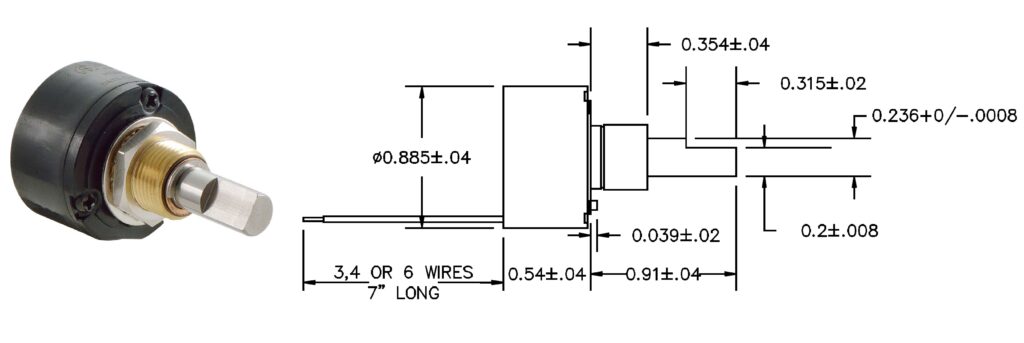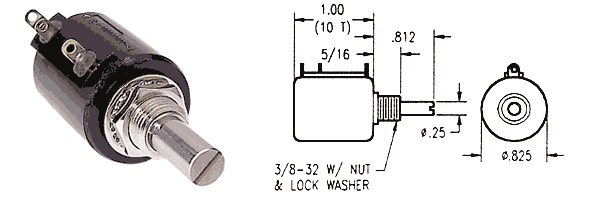Choosing the right potentiometer can make or break your design. For engineers and designers working on motion systems or control panels, understanding the difference between a multi-turn potentiometer and a single-turn potentiometer is essential. Each type serves a different purpose based on how much precision, resistance range, and control your application requires.
In this guide, we’ll break it down clearly—what each potentiometer does, how they work, and when to use which. Whether you’re working on industrial automation, test equipment, or custom electronics, the choice between single-turn and multi-turn isn’t just about preference—it’s about performance.

What Is a Single-Turn Potentiometer?
A single-turn potentiometer is a basic rotary position sensor. It allows you to rotate the knob or shaft just once, typically within 270 degrees. That single turn covers the entire range of resistance measurement, from minimum to maximum. It’s fast, compact, and perfect for applications that don’t require extremely fine adjustments.
Where It Works Best:
- Volume or brightness controls
- Motor speed settings
- Simple control knobs on dashboards
- Quick, user-friendly adjustments
If your system only needs general adjustment and you don’t need to dial in micro-precise values, a single-turn potentiometer gets the job done quickly and efficiently.

What Is a Multi-Turn Potentiometer?
A multi-turn potentiometer is designed for greater control and accuracy. Instead of covering the full resistance in one turn, it spreads that range over 5, 10, or more full rotations. This gives you much finer control over the output and allows for small, precise changes.
Where It Works Best:
- Sensor calibration
- Test and measurement equipment
- Precision control systems
- Industrial automation
Because the resistance range is distributed across more turns, each rotation results in a smaller change—ideal when the slightest variation makes a big difference.
Differences Between Multi-Turn and Single-Turn Potentiometers
| Feature | Single-Turn Potentiometer | Multi-Turn Potentiometer |
| Rotation Range | ~270° | 5 to 10 full turns or more |
| Precision | Basic | High |
| Size | Compact | Larger |
| Control Level | Fast adjustments | Fine-tuned control |
| Cost | Lower | Slightly higher |
| Best For | Simple settings | Accurate calibration |
Understanding Resistance Measurement
At the heart of every potentiometer is resistance measurement. As the knob turns, it moves a wiper across a resistive element, changing the resistance value between terminals. This shift adjusts voltage in a circuit, which is what many control systems use to track or adjust output.
In a single-turn potentiometer, this change happens quickly because all the resistance is covered in just one turn. That’s why it’s great for quick changes but not ideal for micro-adjustments.
In a multi-turn potentiometer, the same resistance is spread over several turns. That makes it easier to hit a specific value with accuracy. You get more control and less chance of overshooting your setting.
Single-Turn Potentiometer Applications in Motion Control
A single-turn potentiometer is well suited for motion control systems where quick adjustments and general feedback are enough. These potentiometers are used in basic position tracking and manual adjustments.
Common uses:
- Basic motor speed control
- Manual dials or knobs on user-facing panels
- Position feedback for less complex actuators
- Low-cost control systems that don’t require high-resolution
Their simplicity and speed make them perfect for operators who need to make fast, reliable changes.
Multi-Turn Potentiometer Applications in Motion Control
A multi-turn potentiometer offers higher resolution and precision, which is vital in advanced motion control systems. Because the resistance change is spread across several turns, it provides more detailed feedback.
Common uses:
- Robotic arms needing accurate joint positioning
- Servo mechanisms requiring fine adjustments
- Industrial machines that demand repeatable calibration
- Sensor alignment systems in closed-loop automation
When systems require small, exact movements, a multi-turn potentiometer provides the control and feedback needed for tight tolerances and reliable automation.
Which One Offers Better Accuracy?
Accuracy comes down to how much control you need. If you’re adjusting a dial from 0 to 100 in a single move, a single-turn potentiometer is usually enough. But if you need to adjust in 0.1 steps or smaller increments, a multi-turn potentiometer is the better option.
Think of it like turning a water valve:
- A single-turn version is like quickly opening the tap all the way.
- A multi-turn version is like slowly turning the tap to get just the right drip-rate.
When working with motion control or sensitive calibration, accuracy often makes the difference between smooth performance and wasted effort.
Benefits and Trade-Offs
Let’s take a closer look at what you gain or give up with each choice.
Single-Turn Potentiometers:
Pros:
- Quick response time
- Compact and easy to mount
- Lower cost
- Great for straightforward controls
Cons:
- Less accurate
- Not ideal for fine-tuned systems
- Limited resolution
Multi-Turn Potentiometers:
Pros:
- Superior accuracy
- Excellent for calibration
- Allows gradual, controlled adjustments
Cons:
- Slightly larger in size
- Takes longer to adjust
- Higher cost (but worth it for critical systems)
Cost vs. Performance
In budget-sensitive projects, the single-turn potentiometer often wins out. It offers a simple way to get position or resistance values without the added cost of advanced control.
But in systems where precision and control are essential—such as lab instruments or advanced automation—the extra investment in a multi-turn potentiometer pays off in better results and fewer errors.
Consider this: if you’re designing a system that will be calibrated once and left alone, maybe you don’t need 10 turns of precision. But if it’s something that needs ongoing adjustment or exact alignment, every extra turn gives you better control.
When to Use Each Type of Potentiometer
Use a Single-Turn Potentiometer If:
- You need fast adjustments
- You’re limited on space
- You’re building simple, low-cost controls
- You don’t need ultra-precise settings
Use a Multi-Turn Potentiometer If:
- Precision matters
- The application needs fine-tuning
- You’re working with feedback systems or calibration tools
- The system operates in a sensitive or technical environment
How They Fit into Larger Systems
Whether it’s a simple motor speed dial or a precision test bench, potentiometers play a role in how systems behave. As components of larger motion control designs, they act as the bridge between human input or mechanical movement and the electronics that respond.
In both analog and digital systems, potentiometers help set limits, adjust responses, and provide feedback. That’s why choosing between multi-turn and single-turn isn’t just a checkbox—it affects how your system performs day after day.
Why Engineers Rely on the Right Fit
Choosing the wrong potentiometer can lead to overcorrection, underperformance, or constant recalibration. Engineers trust multi-turn potentiometers when they need that extra resolution and dependability. On the other hand, for quick adjustments and general controls, the single-turn potentiometer is a reliable, time-tested choice.
If you’re building something that needs both precision and flexibility, sometimes a mix of both types across different control points is the smartest move.
Pick the Potentiometer That Delivers
Both multi-turn potentiometers and single-turn potentiometers have earned their place in electronic and mechanical design. Each has its own strengths, and the right one depends on your needs for resistance measurement, adjustment range, space, and how your motion control system is expected to perform.
Before you choose, think beyond specs. Think about how the system will be used, how often it will be adjusted, and how precise it really needs to be.
Choose smart. Choose what fits the function. And let your potentiometer do the heavy lifting—one turn at a time.

Nice post! 1754743132
Gol makinesi siz rakibi çözdünüz helal takım ssupsw.in
9404229424
5223626282
7720899110
1192004151
9740384603
batara88: batara88 – batara88